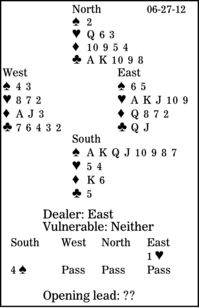Bridge column, June 27: First spot card tells a length story

As anyone who has ever been around a bridge table for any length of time should well know, telling partner the length of your holding in his suit may be vital.
This week we are looking at playing the right spot cards. In this deal, East opens one heart, South jumps to four spades, and everyone passes. What should West lead?
Note South's four-spade overcall. He needs so little from partner to make game laydown. (The diamond ace is sufficient.) Also, given East's opening bid, it is unlikely that his side can make a slam. Four spades is so much more likely to inconvenience the responder than miss a slam.
When making the opening lead, the general principle is that a low card from a three-card or longer suit guarantees at least one honor in that suit. However, when leading partner's unsupported suit, the rules are high from a doubleton; or low from three-plus, even without an honor in the suit. Here, West must lead the heart two. Then, after East wins with his nine and cashes the ace, he will know that South is out of hearts. East will shift to the diamond two (low guaranteeing an honor in that suit), and the defense will win the first four tricks.
If West leads the heart eight, that shows a singleton or a doubleton. East will expect to cash a third heart trick, but South will ruff, draw trumps and run the clubs for an overtrick.
** ** **
COPYRIGHT: 2012, UNITED FEATURE SYNDICATE
DISTRIBUTED BY UNIVERSAL UCLICK FOR UFS

